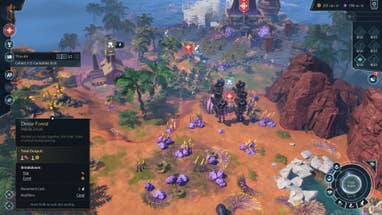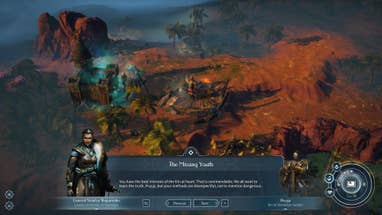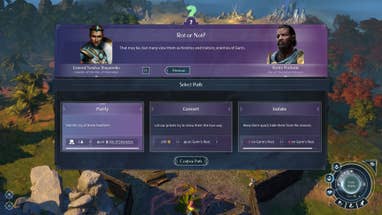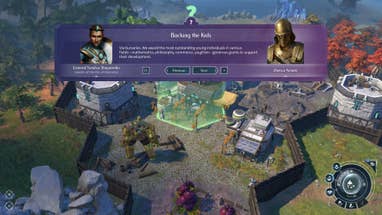The legend goes that in the 12th century, King Canute plonked his throne down on the seashore and commanded the tide to go out, thereby empirically demonstrating to all the toadies at court that he was not, in fact, God Almighty. You don’t need to order the ocean to piss off in Endless Legend 2: it’s already in headlong retreat. But not from you.
At intervals throughout Amplitude’s new 4X strategy game (the studio’s first reveal since they bought their independence back from Sega) mysterious “tidefall” events cause the surrounding waters to plummet and reveal a new expanse of hexagonal terrain, rich with questable dungeons and other eldritch sights. A world map that began as an Earthsea-style archipelago gradually becomes a set of proper continents, with more opportunities to meet and out-gambit other factions, and more secrets to discover. It’s an evolution of the first Endless Legend’s seasonal dynamics, and “the beginning of an answer” to what Amplitude co-founder Romain de Waubert de Genlis describes as a classic 4X challenge: keeping players interested beyond the early game, once every last scrap of territory has been disclosed.
“With tidefalls what we’re trying to achieve is to answer an issue that 4X games have most of the time,” he tells me over videocall. “The first X being explore, which tends to be the “X” that you love at the beginning of the game, but obviously you don’t have it at the end, because you’ve explored everything. With tidefalls, we’ve tried to find a way to always have something new to discover, and have to fight for it or have to rush for it, so it could create tension all the way through the game. So we thought that maybe we’re solving this, and I hope that will be the case – I think it is getting close, but we still have some problems.”


I’ve played around a hundred turns of an Endless Legend 2 preview build, and I can confirm that tidefalls keep things intriguing, though I’m still deciding how transformative they are. Playing initially as the Kin Of Sheredyn – a Vaulter-style faction of Greco-Roman mechanauts who are all about massively overdeveloping a smaller handful of cities in return for spiritual boons – I founded my capital on a peninsula, trading easy resource access for defensibility. Always keen to place my back to a wall, me. A few dozen turns later, the waves shrank away to reveal a cosmic “splintered” dungeon, ready and waiting on my coastline for my heroes to plunder.
It refreshes the experience in a way similar to age transitions in Amplitude’s historical 4X Humankind (and Sid Meier’s Civilization VII), but it’s more conceptually pleasing. And eye-catching. The balance of power erodes and new opportunities arise. Seabeds surface and all manner of slithering oddity offers itself to the light. I’m still figuring out all the variables, but tidefalls also play into the evolving strengths and weaknesses of the factions. The Aspect, for example, are a bunch of passive-aggressive harmony-loving culture warriors who can seed map tiles with self-spreading coral, which acts as both a sensory network and a sleeper agent bending other civs to your will. If the coral-spored tile is an ocean tile, your units can walk on it, so the sneaky reef-herders have a manoeuvring advantage while the waves are high.
For all that, I do wonder if Endless Legend 2’s real draws will be its quieter, more pragmatic changes to the 2014 game. It has some familiar strengths. At heart, this feels like the same, gracefully imagined 4X with an undercurrent of florid RPG questing. Tersely worded, more-ish storylets pop up as your settlements expand and you meet other factions. The core civ resources are as before: science, production, food, influence and magical dust, plus strategic or exotic resources that are required for certain constructions. You’ll assign Pops to different kinds of resource generation, and meticulously assemble districts on hexes around your city hub. There’s a choice of regular, disposable units and deathless heroes, who have skill trees and equipment slots. And there are the usual minor factions with unique units to either destroy or pacify and stir into your cultural hotpot.

It’s all held together by Amplitude’s usual lush sci-fantasy art, which goes down extra-smooth thanks to a mouse-wheel zoom that suavely trades the 3D geography for a more digestible flat map. The choice of an oceanic planet has allowed for a funkier spread of mottled, Vandemeerian hues, and the city models are more detailed and distinctive, with flourishes such as the thump of a farm’s watermill. The city management screens are fuller and less spreadsheety, with portraits instead of icons; I look forward to the forum arguments about which game’s interface is better.
There all kinds of tweaks and twiddles throughout. Influence, for example, can now be spent to colonise hexes beyond your city wall and bring them into the fold. The biggest revision of all, so far, is that battles are no longer real-time with regular pauses to issue orders, but turn-based. “They are a continuation of Humankind,” explains de Waubert de Genlis. “So coming from Humankind, it’s not that different – it’s an improvement on elements like the animations, details here and there on the units fighting. But from Endless Legend 1, it is huge improvement. Because Endless Legend 1, I love the concept [of the battle system], but half of the people loved it, half hated it.”
I was Team Not Too Fussed Either Way, myself, but Endless Legend 2’s system definitely feels like an improvement, allowing you to more predictably arrange your squads on tiles that confer buffs. The factions have similar unit types, but are nicely distinguished at the level of both individual unit skills and army-wide tactical chemistry. Aspect units, for example, gain an attack boost when one of their number defends. Swarm a turtling coral drone formation that appears to have been left unsupported, and you’re feeding the Aspect counterpunch. The Kin Of Sheredyn are more routine in their tactics: it’s all about locking enemies down with shield walls and sending in the archers and cavalry.

I suspect it would prove much more controversial than the first game’s battle system, but the obvious thing Endless Legend 2’s tidefall mechanic leaves me wondering is whether Amplitude have considered letting the oceans rise, as they do when you melt the ice caps in Sid Meier’s Alpha Centauri. If adding more terrain preserves the element of curiosity, removing it might cut through the familiar endgame tedium of having to govern a vast empire. Personally, I’d love to play a 4X with geography that’s as precarious and exhilarating as, say, the treacherous sands of Ubisoft’s ancient Populous-alike, From Dust.
Sadly, it doesn’t sound like there’s anything quite so dramatic in store. “We did discuss at the beginning, having [the sea] recess and come back,” de Waubert de Genlis tells me. “But we realised that no one likes to see what you’ve built destroyed, all your armies washed away after you worked for 50 turns on that army. So that’s why we thought, OK, let’s go in one direction. In general with our games, we try not to take anything away from you. We try always to give you something.”
I’m pretty sure this is exactly the mindset the old Canute legend is supposed to discourage. Players aren’t gods either, Amplitude! Let us get our feet wet. Let us reckon with the sea’s hunger, rather than rolling back the ocean like giftwrap. De Waubert de Genlis does caveat, however, that there’s more to tidefalling than presently meets the eye, and that the aquatic dynamics may change as Endless Legends 2 proceeds through early access. “There’s some cool stuff coming along the way. Water is definitely at the centre of the player’s attention, and there are a lot of things that could be done around that.”
Source link











Add comment